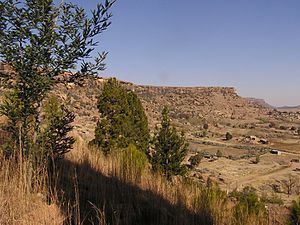 | ||
Similar Maletsunyane Falls, Katse Dam, Sehlabathebe National Park, Mohale Dam, Ts'ehlanyane National Park | ||
Thaba bosiu top 9 facts
Thaba Bosiu is a sandstone plateau with an area of approximately 2 km2 and a height of 1,804 meters above sea level. It is located between the Orange and Caledon Rivers in the Maseru District of Lesotho, 24 km east of the country's capital Maseru. It was once the capital of Lesotho.
Contents
Map of Thaba Bosigo, Lesotho
In the early 19th century, the Basotho chief Moshoeshoe I established a stronghold on the plateau to act as a refuge for his people during a war with the Ndebele people. At an elevation of nearly 120 metres above the surrounding area, the plateau formed a natural fortress to gather the Basotho people in times of danger. The plateau's large area meant it could hold enough livestock and provisions to support the people during a lengthy siege.
The word Thaba means mountain in the Sesotho language and Bosiu means 'at night'. The name mountain of the night echoed the local belief that the mountain grew during the night and shrunk during day, leaving enemies who tried scaling it during the night still stranded on the cliffs and vulnerable for attack next morning.
Thaba Bosiu also acted as Moshoeshoe's headquarters during the various Basuto Wars. During the first Free State–Basotho War against the Orange Free State in 1858, the Free State's commandoes tried assaulting the stronghold, but met with little success. During the third war against the Free State in 1868, Thaba Bosiu was the only stronghold in Basutoland that wasn't stormed by the Free State forces. In the time the stronghold remained manned, it was never taken by the enemy. When Moshoeshoe died in 1870, he was buried on Thaba Bosiu.
The settlement on Thaba Bosiu has since been abandoned, and only ruins and the graves of various Basotho chiefs remain. The plateau is currently a national monument and often visited by tourists.
